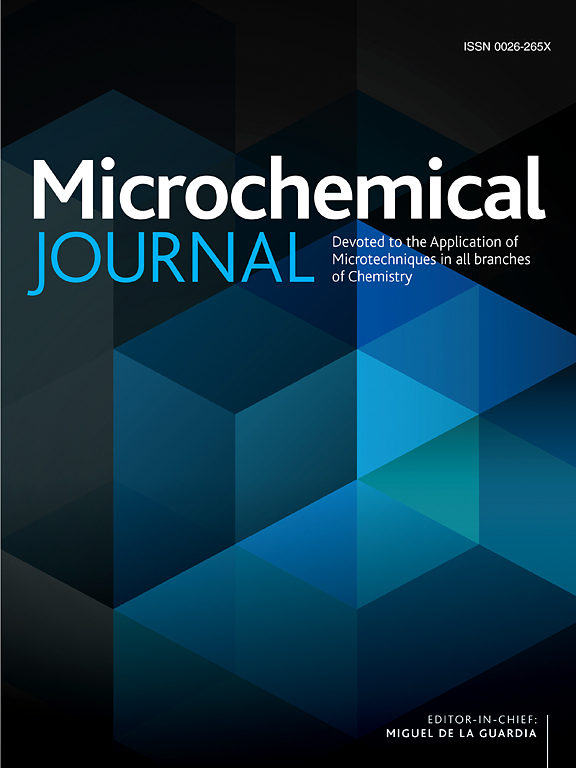Recent progress in noble metal-based single-atom nanozymes for biomedical applications
IF 4.9
2区 化学
Q1 CHEMISTRY, ANALYTICAL
引用次数: 0
Abstract
Nanozymes are nanomaterials with enzymatic properties designed to overcome the inherent limitations of natural enzymes. They can mimic various enzyme activities with durability, low cost, and tunable catalytic properties. With the rapid development of nanotechnology, biotechnology, catalytic science, and computational chemistry, remarkable progress has been made in the research of nanozymes. However, compared with natural enzymes, the reported nanozymes possess lower catalytic activity, which limits their further application. Single-atom nanozymes (SAzymes) are a new type of nanozymes that have been widely explored in recent years. With their maximum active site density and well-defined coordination environment, SAzymes have demonstrated excellent catalytic performance, showing broad application prospects in many fields such as biosensing, antibacterial, and tumor therapy. Furthermore, the well-defined atomic coordination and electron configuration of SAzymes provide strong support to reveal the complex mechanism of their catalytic reaction. Particularly, the noble metal-based SAzymes precisely synthesized on the atomic scale, inherit the advantages of SAzymes, while combining the excellent electronic conductivity, high stability and good catalytic activity of noble metals. This effectively reduces the production cost and gives the noble metal-based SAzymes a great potential for practical applications. In this review, we focus on the recent advances of noble metal-based SAzymes in biomedicine and discuss their underlying challenges as well as future prospects.

用于生物医学应用的贵金属基单原子纳米酶的最新进展
纳米酶是一种具有酶特性的纳米材料,旨在克服天然酶的固有局限性。它们可以模拟各种酶的活性,具有耐久性、低成本和可调的催化特性。随着纳米技术、生物技术、催化科学和计算化学的快速发展,纳米酶的研究取得了显著进展。然而,与天然酶相比,已报道的纳米酶具有较低的催化活性,这限制了它们的进一步应用。单原子纳米酶(SAzymes)是近年来被广泛探索的一种新型纳米酶。单原子纳米酶具有最大的活性位点密度和明确的配位环境,表现出优异的催化性能,在生物传感、抗菌、肿瘤治疗等多个领域展现出广阔的应用前景。此外,SAzymes 明确的原子配位和电子构型为揭示其催化反应的复杂机理提供了有力支持。特别是在原子尺度上精确合成的贵金属基 SAzymes,在继承 SAzymes 优点的同时,兼具贵金属优异的电子传导性、高稳定性和良好的催化活性。这有效降低了生产成本,使贵金属基 SAzymes 在实际应用中大有可为。在这篇综述中,我们将重点介绍贵金属基 SAzymes 在生物医学领域的最新进展,并讨论其背后的挑战和未来前景。
本文章由计算机程序翻译,如有差异,请以英文原文为准。
求助全文
约1分钟内获得全文
求助全文
来源期刊

Microchemical Journal
化学-分析化学
CiteScore
8.70
自引率
8.30%
发文量
1131
审稿时长
1.9 months
期刊介绍:
The Microchemical Journal is a peer reviewed journal devoted to all aspects and phases of analytical chemistry and chemical analysis. The Microchemical Journal publishes articles which are at the forefront of modern analytical chemistry and cover innovations in the techniques to the finest possible limits. This includes fundamental aspects, instrumentation, new developments, innovative and novel methods and applications including environmental and clinical field.
Traditional classical analytical methods such as spectrophotometry and titrimetry as well as established instrumentation methods such as flame and graphite furnace atomic absorption spectrometry, gas chromatography, and modified glassy or carbon electrode electrochemical methods will be considered, provided they show significant improvements and novelty compared to the established methods.
 求助内容:
求助内容: 应助结果提醒方式:
应助结果提醒方式:


